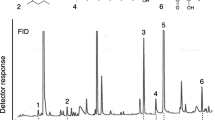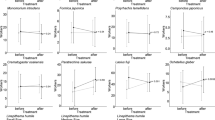Summary
Laboratory experiments on circular artificial trails show that the beetleEdaphopaussus favieri follows the trail of its host ant,Pheidole pallidula. After having been isolated for a certain time, the beetle greatly improves its trail-following ability once it is again in contact with workers.
The optimal response ofE. favieri occurs for a concentration of 0.03 minor worker's poison glands per cm. Minor and major workers are respectively 10 and 4 times more sensitive. High trail pheromone concentrations, from 0.06 glands/cm onwards, repel the beetle, not the workers. This avoidance effect is also found with wholePh. pallidula's poison and mandibular glands, with volatiles from the Dufour's gland and with poison gland extracts presented in the form of a dot, in front of the beetle. The trail following ofE. favieri is host-specific.
The adaptive value of the trail-following characterisitcs ofE. favieri is discussed.
Resume
Des expériences sur une piste circulaire artificielle montrent que le coléoptèreEdaphopaussus favieri suit la piste de sa fourmi hôte,Pheidole pallidula. Si le coléoptère a été préalablement maintenu isolé, la mise en présence d'ouvrières améliore son suivi de la piste.
E. favieri réagit de façon optimale à une concentration de 0.03 glandes à poison d'ouvrière minor par cm. Les ouvrières minor et major sont respectivement 10 et 4 fois plus sensibles que le coléoptère à la phéromone de piste. Contrairement aux ouvrières, le coléoptère est repoussé par des concentrations égales ou supérieures à 0.06 glandes/cm. Cet effet répulsif s'observe aussi pour des glandes à poison et des glandes mandibulaires. entières, dePh. pallidula, ainsi quue pour les produits volatils de la glande de Dufour et certaines concentrations d'extraits de glandes à poison présentés ponctuellement en face du coléoptère.E. favieri suit uniquement la piste de son hôte.
La valeur adaptative des différentes caractéristiques du suivi de la piste parE. favieri est discutée.
Similar content being viewed by others
References
Akre R.D., Rettenmeyer C.W., 1968—Trail-following by guests of army ants (Hymenoptera: Formicidae: Ecitonini).J. Kansas Ent. Soc., 41, 165–174.
Cammaerts R., Cammaerts M.-C., Detrain C., 1989.—Response of the Myrmecophilous BeetlesEdaphopaussus favieri (Carabidae Paussinae) andDichillus minutus (Tenebrionidae) to the Trail of their Host,Pheidole pallidula.Actes Coll. Insectes Soc., 5, 199–206.
Delalande C., 1985.—Rythmes d'activité de quelques espèces de fourmis en région méditerranéenne (Hym. Formicidae).Actes Coll. Insectes Soc., 2, 303–318.
Deneubourg J.L., Aron S., Goss S., Pasteels J.M., Duerinck G., 1986.—Random behaviour, amplification processes and number of participants: how they contribute to the foraging properties of ants.Physica, 22D, 176–186.
Detrain C., Pasteels J.M., 1987.—Morphological and Biochemical Differences in the Abdominal Glands ofPheidole pallidula (Myrmicinge). InEder (J.) andRembold (H.):Chemistry and Biology of Social Insects, 447–448. Peperny, München.
Detrain C., Pasteels J.M., Deneubourg J.L., 1988.—Polyéthisme dans le tracé et le suivi de la piste chezPheidole pallidula (Formicidae).Actes Coll. Insectes Soc., 4, 87–94.
Escherich C., 1899.—Zur Naturgeschichte vonPaussus favieri Fairm.Verh. Zool.-bot. Ges. Wien, XLIX, 278–283.
Howard R.W., 1980.—Trail-Following by termitophiles.Ann. Ent. Soc. Am., 73, 36–38.
Le Masne G., 1961a.—Recherches sur la biologie des animaux myrmécophiles: observations sur le régime alimentaire de «Paussus favieri» Fairm., hôte de la fourmi «Pheidole pallidula» Nyl.C. R. Acad. Sci., Paris, 253, 1356–1357.
Le Masne G., 1961b.—Recherches sur la biologie des animaux myrmécophiles. IV. Observations sur le comportement dePaussus favieri Fairm., hôte de la fourmiPheidole pallidula Nyl.Ann. Faculté Sc. Marseille, 31, 111–130.
Moser J.C., 1964.—Inquiline Roach Responds to Trail-Marking Substance of Leaf-Cutting Ants.Science, 143, 1048–1049.
Wilson E.O., 1976.—The Organization of Colony Defense in the Ant Pheidole dentata Mayr (Hymenoptera: Formicidae).Behav. Ecol. Sociobiol., 1, 63–81.
Author information
Authors and Affiliations
Rights and permissions
About this article
Cite this article
Cammaerts, R., Detrain, C. & Cammaerts, M.C. Host trail following by the myrmecophilous beetleEdaphopaussus favieri (Fairmaire) (Carabidae Paussinae). Ins. Soc 37, 200–211 (1990). https://doi.org/10.1007/BF02224048
Received:
Accepted:
Issue Date:
DOI: https://doi.org/10.1007/BF02224048




